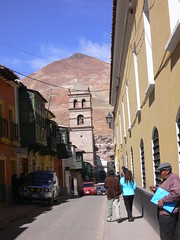¡Es un Potosí!

Up here in the Andes, it seems there´s a superlative for everything. After Uyuni, we headed to Potosí, which is lucky enough to have two! Not only was it for a long time the richest city in South America, thanks to its silver mines, it is also the highest city of its size in the world (altitude 4,070 meters, population 110,000). In the 1500s, the export of silver from Potosí was the main reason for the colonisation of much of the rest of South America. The Spanish expression ¡es un Potosí! means something is really rich. Major cities were founded to provide customs checkpoints and exit roads for the silver en route to Europe. If there was no Potosí, there would be no Lima and no Buenos Aires. For this reason, I was excited to check it out. However, getting there involved what was supposed to be a 6-hour bus ride. As only 5% of Bolivian roads are paved, I was expecting a bumpy ride. However, what I didn´t expect was that we would have to stop twice for mechanical difficulties, including one time when they actually had to take a tire off of the bus to repair the problem. Then the road was so bad that it took us 3 hours alone to go the last 90 km! In the end, the ride took 9 hours and I was extremely happy to finally arrive.
Potosí has changed a lot in the past 400-500 years. For one thing, the mines were basically tapped out, and the remaining ones were privatized in the 1980s and are run as cooperatives. They now produce much humbler amounts of silver, as well as iron, tin and all kinds of other metals. However, the work conditions for miners have changed very little over the centuries, which results in occasional strikes and protests by miners´ unions. We took a tour of the Casa Nacional de Moneda, where all coins for Bolivia as well as Spain were made for hundreds of years. Now, Bolivian coins are made in Spain and Canada, and their bills are produced in France. However, despite not being quite as powerful a city as it was in its heyday, Potosí is still a really nice city, bustling with activity, people all over the place, streets full of buses with young boys employed to stand in the doorways shouting out the buses´ destination. The city is surrounded by mountains, and it seems every time I turned a corner I was looking down a street at the mountains in the distance...a really surprising and beautiful sight.
Let me just expand a little on the effects of altitude. Although we had been at or around 3,500-4,000 meters of altitude for at least a week, for some reason in Potosí the thin air seemed to hit everyone like a ton of bricks. While people who suffer from real altitude sickness (nausea, vomiting, killer headaches, dizzyness) tend to get it right away, or at least within a day or so, the fact is that when you´re at 4,000 meters there just isn´t enough air to fill your lungs the way you´re accustomed to. I´m a pretty fast walker, and I really had to slow myself down, or else I would get winded. Talking to other gringos, it seems lots of people had the same experience--we sometimes find ourselves short of breath after the smallest exertion, like crossing the room or even just lifting a heavy backpack. The other thing to remember about being up in the Andes is that it´s cold up here, and most hotels (in my budget, anyway) don´t have heating! At midday, in the sun, it´s lovely and warm, but outside of these conditions it gets chilly, and once the sun goes down it is downright freezing! It took several alpaca-wool blankets on the bed to defrost my bones. So much for being officially in the tropics! (Having crossed the Tropic of Capricorn in northern Argentina and Chile, you´d think it would be warm here. You´d be wrong.)












<< Home